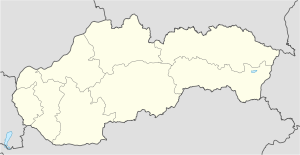Čremošné tunnel
|
Čremošné tunnel Harmanec tunnel
|
||
|---|---|---|
| Official name | Čremošniansky tunel | |
| use | Railway tunnel | |
| traffic connection | Banská Bystrica – Dolná Štubňa railway line | |
| length | 4697 m | |
| Number of tubes | 1 | |
| business | ||
| operator | ŽSR | |
| release | December 19, 1940 | |
| location | ||
|
|
||
| Coordinates | ||
| Čremošné | 48 ° 50 ′ 22 " N , 18 ° 57 ′ 24" E | |
| Harmanec | 48 ° 49 ′ 55 " N , 19 ° 1 ′ 11" E | |
The Čremošné tunnel ( Slovak : Čremošniansky tunel , also called Harmanec tunnel ) is the longest railway tunnel in Slovakia and the former Czechoslovakia at 4697 m . It is located on the Banská Bystrica – Dolná Štubňa railway line (km 27.847 – km 32.544) and passes under the Malý Šturec saddle (at the transition between the Great Fatra and Kremnicky Mountains ) between the eponymous place Čremošné on the west side and Harmanec on the east side. It is a top tunnel and the last of a total of 22 tunnels on the railway line, seen from Banská Bystrica (but it is number 14). The tunnel is single-track and not electrified.
From a geological point of view, the tunnel traverses rock layers made up of dolomite (47%), marl limestone (34%) and Gutenstein limestone (19%). The groundbreaking for the construction of the tunnel and the entire railway line took place in the presence of the President of Czechoslovakia Edvard Beneš on September 28, 1936. The construction method was based on the Austrian tunneling method, like the Busserl tunnel near Gumpoldskirchen in Lower Austria almost 100 years earlier . The tunnel water posed a major problem ; the strength on the east side briefly reached the maximum value of 800 l / sec. Nevertheless, after almost two years of construction, the straightening tunnel was cut through on August 28, 1938. A shaft was built around the middle. The railway line with the tunnel was opened on December 19, 1940.
Originally the tunnel was named after Edvard Beneš. During the time of the First Slovak Republic after the end of Czechoslovakia in 1939, he was named Andrej Hlinka by ordinance .
Web links
- Tunel č. 14 - Čremošniansky. Information about the tunnel on rail.sk
- Tunely na trati Banská Bystrica - Dolná Štubňa.

